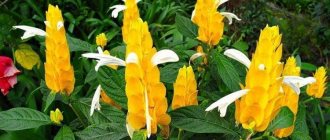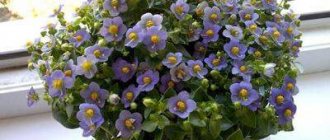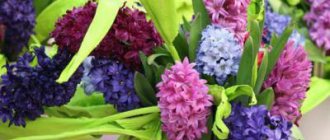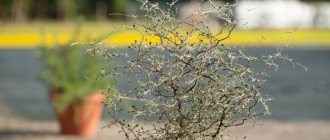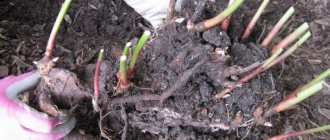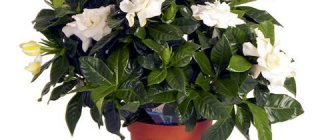List of plants starting with the letter "H"
Nandina (lat. Nandina)
Nandina is the only representative of the genus and is referred to as home nandina or Nandina domestica. Under natural conditions, this plant can be found on the mountain slopes of China and Japan.
Nandina home (lat. Nandina domestica)
Narcissus (lat. Narcissus)
Since there are many varieties of daffodils (more than 3000 varieties), it is not difficult to choose the ones that suit your taste in color, smell and shape. There are 12 groups of them.
Nasturtium cultivated (Capucin) (lat. Tropaeolum)
In May, nasturtium seeds can be sown in open ground in holes (at a distance of 25 cm). To start flowering earlier, you can grow seedlings.
Nematanthus (Hypocyrta) (lat. Hypocyrta)
Direct sunlight has a bad effect on nematanthus. Moderate diffused lighting is optimal for it. It is best to choose window sills for the plant on the east and west sides of the room.
Nematanthus smooth (Hypocyrta, Hypocyrta naked) (lat. Hypocyrta glabra)
Neomarica (lat. Neomarica)
Neomarica slender grows up to 180 cm and is distinguished by narrow sword-shaped leaves. The leaves are green, leathery, fan-shaped, reaching 60 cm in length.
Neomarica slender (Walking iris) (lat. Neomarica gracilis)
Neoregelia (Aregelia) (lat. Neoregelia)
Aregelia (syn. Neorelegia) (lat. Aregelia) belongs to the Bromeliad family (lat. Bromeliaceae) and is a life form of herbaceous plants.
Neoregelia Carolina (lat. Neoregelia carolinae)
Neoregelia spectabilis (lat. Neoregelia spectabilis)
Related article: Plant fertilizers: mineral and organic
Nepenthes (lat. Nepenthes)
Nepenthes has large leaves with a well-defined convex vein. Their top is slightly retracted. Also on the stem grow pitcher-shaped leaves, the petiole of which is wide, flattened and green in color at the bottom.
Nepenthes hybrid (Nepenthus, Pitcher, Hunter's cup, Zhiryanka) (lat. Nepenthes hybridus)
Nerina (Nerine) (lat. Nerine)
Nerina is characterized by fairly long leaves that have a belt-like shape.
Nerina Bowden (lat. Nerine bowdenii)
Nertera (lat. Nertera)
Nertera requires good lighting; direct sunlight is not allowed (preferably partial shade). In warm weather, you need to take it out into the air, protecting it from the sun, precipitation and drafts.
Nertera grenada (Nertera pressed) (lat. Nertera granadensis)
Nephrolepis (lat. Nephrolepis)
Nephrolepis has fluffy, feathery leaves, often called fronds, which form a bright, lush crown above the flowerpot and can reach a length of 70 cm.
Nephrolepis exaltata (lat. Nephrolepis exaltata)
Nephrolepis cordifolia (lat. Nephrolepis cordifolia)
Nidularium (lat. Nidularium)
Nidularium (lat. Nidularium) belongs to the Bromeliaceae family. This plant has a very exotic appearance and decorative leaves.
Nidularium billbergioides (lat. Nidularium billbergioides)
Nidularium Innocent (lat. Nidularium innocentii)
Nile lily (Agapanthus umbellatus) (lat. Agapanthus umbellatus)
Agapanthus, or Agapanthus in Latin, is a perennial plant native to South Africa. Decorative rosettes of long, strap-shaped leaves and an umbrella inflorescence on a peduncle up to a meter high make agapanthus a real beauty.
Large-leaved footcarp (Podocarpus) (lat. Podocarpus)
Large-leaved footcarp (lat. Podocarpus macrophyllus) belongs to the family Podocarpaceae (lat. Podocarpaceae). This is a large coniferous plant, the life form of which is a tree. The most distinctive feature of the large-leaved plant is its needles.
Nolina (Beaucarnea) (lat. Nolina, Beaucarnea)
Nolina recurvata (Bocarnea, Elephant's foot, Nolina recurvata)
Encyclopedia of gardening, floriculture and landscape design
Nandina - Indoor plants Nandina domestica - Indoor plants Foxglove - Herbaceous plants for open ground Foxglove grandiflora - Herbaceous plants for open ground Foxglove purpurea - Herbaceous plants for open ground Foxglove woolly - Herbaceous plants for open ground Naranjilla - Vegetable crops Narcissus - Herbaceous plants for open ground soil Narcissus hybrid - Herbaceous plants for open ground Narcissus - Plants for ponds Nasturtium - Lianas Nasturtium - Vegetable crops Nasturtium - Herbaceous plants for open ground Nasturtium large - Creepers Nasturtium large - Vegetable crops Nasturtium large - Herbaceous plants for open ground Nasturtium foreign - Lianas Nasturtium foreign - Herbaceous plants for open ground Nasturtium Canary - Creepers Nasturtium Canary - Herbaceous plants for open ground Nasturtium cultivated - Creepers Nasturtium cultivated - Herbaceous plants for open ground Naumburgia racemosa - Herbaceous plants for open ground Nahud - Vegetable crops Impatiens - Indoor plants Impatiens - Herbaceous plants for open ground Impatiens impatiens - Herbaceous plants for open ground Forget-me-not - Plants for ponds Forget-me-not - Herbaceous plants for open ground Forget-me-not alpine - Herbaceous plants for open ground Forget-me-not swamp - Plants for ponds Forget-me-not swamp - Herbaceous plants for open ground Forget-me-not hybrid - Herbaceous plants for open ground Forget-me-not - Plants for ponds Forget-me-not - Herbaceous plants for open ground Garden forget-me-not - Herbaceous plants for open ground Forget-me-not - Herbaceous plants for open ground Neklen - Ornamental trees and shrubs Nectaroscordum - Herbaceous plants for open ground Nectaroscordum dioscoride - Herbaceous plants for open ground Nectaroscordum sicilianum - Herbaceous plants for open ground Nematanthus smoothis - Indoor plants Nemesia - Herbaceous plants for open ground Nemesia hybrid - Herbaceous plants for open ground Nemesia goiter - Herbaceous plants for open ground Nemophila - Herbaceous plants for open ground Nemophila Mencisa - Herbaceous plants for open ground Neomarica - Indoor plants Neoregelia - Indoor plants Neoregelia Carolina - Indoor plants Nepenthes - Indoor plants Nepenthes hybridis - Indoor plants Nepenthus - Indoor plants Nerine - Indoor plants Nerine Bowden - Indoor plants Nerthera - Indoor plants Nerthera grenadica - Indoor plants Nerthera pressed - Indoor plants Nephrolepis - Indoor plants Nephrolepis sublime - Indoor plants Nephrolepis cordifolia - Indoor plants Nephrolepis - Herbaceous plants for open ground Nephrolepis greatest - Herbaceous plants for open ground Common nephrolepis - Herbaceous plants for open ground Nigella - Vegetable crops Nigella - Herbaceous plants for open ground Nidularium - Indoor plants Nidularium Innocentia - Indoor plants Nile lily - Indoor plants Nymphaeum - Plants for ponds Nymphaeum - Plants for ponds Nymphoides - Plants for ponds Threads of pearls - Indoor plants New Zealand laurel - Indoor plants Marigold - Herbaceous plants for open ground Marigold - Herbaceous plants for open ground Nolina - Indoor plants Nolina oblique - Indoor plants Nolina bent - Indoor plants Ackermann's Nopalcoxia - Indoor plants Night beauty - Herbaceous plants for open ground Night candle - Herbaceous plants for open ground Night violet - Herbaceous plants for open ground Night violet - Herbaceous plants for open ground Chickpeas - Vegetable crops Nutallia - Ornamental trees and shrubs
What plants begin with the letter H?
Plants starting with the letter H:
- forget-me-not (a very beautiful and unpretentious plant, which is why it has become so popular among gardeners)
Article on the topic: Family of Poat grasses (Geraceae) plants: list, description, genera and species
- foxglove (these flowers, despite their beauty and unpretentiousness, are poisonous, so they should not be planted in places where small children walk)
- marigolds (another name is calendula)
- nasturtium (this plant is used not only to decorate the garden, but it can also be eaten)
- nephrolepis (one of the fern species)
- legcarp (evergreen coniferous plant)
- nolana (long-blooming annual flower, grows like a “carpet” on the ground)
- nomocharis (a very beautiful but rare flower)
- cornflower (flowers resemble daisies)
- nemophila (annual plant similar to buttercup)
- night violet
I will also try, without repeating what was said earlier, to add a few more plants whose names begin with the letter “N”.
Nirembergia is a plant from the nightshade family that has light purple or white flowers with a purple center.
Neoregelia - during the flowering period, the inner parts of the leaves of this plant become bright red, and a flower of amazing beauty blooms in the center. The edges of the leaves are armed with small but sharp thorns.
Nicotiana is poisonous, but so charming!
I’ll try to offer my own list of various plants that begin with the letter “N”. So.
Nutallia, nolina, marigolds, nymphea, nigella, forget-me-not, impatiens, nasturtium, nephrolepis, notocactus, nepenthes, night beauty, nolina, nerine, nidularium, nomocharis, nertera, underripe, cornflower, nymphea, chickpeas, narcissus, foxglove, threadfoil, etc. .d.
I'll start with a plant like nasturtium ! And there are as many as ninety species! I heard you can eat it! I haven't tried it myself.
I really like the marigolds. The plant is bright orange, often grows in flower beds, and is very healing. Its other name is calendula . I buy calendula tincture at the pharmacy when I have a sore throat, gargle with it and everything goes away.
Trees starting with "H".
Nectarine - this plant is similar to both a plum and a peach at the same time. Grows up to seven meters in height.
Article on the topic: Family of Lamiaceae plants: list, description, genera and species
Shrubs starting with "N".
Nutallia. In another way, this ornamental tree, which is more like a shrub, is called osmaronia and emleria.
Other plants starting with "H".
Nolina (houseplant), marigold (this is a well-known herbaceous flowering plant intended for open ground).
Nymphea is a water lily that looks great in ponds and belongs to the water lily family.
Nigella is also an interesting flower, similar to a buttercup.
Forget-me-not has many types of different beauty.
Impatiens is the name given to balsam. I love this name and these flowers.
Food products (alphabetically):
List of all plants starting with the letter t (full catalog of names)
Do you know that:
According to WHO research, talking on a mobile phone for half an hour every day increases the likelihood of developing a brain tumor by 40%.
In order to say even the shortest and simplest words, we use 72 muscles.
Each person has not only unique fingerprints, but also tongue prints.
During operation, our brain expends an amount of energy equal to a 10-watt light bulb. So the image of a light bulb above your head at the moment an interesting thought arises is not so far from the truth.
The human stomach copes well with foreign objects without medical intervention. It is known that gastric juice can even dissolve coins.
Many drugs were initially marketed as medicines. Heroin, for example, was originally brought to market as a cure for children's coughs. And cocaine was recommended by doctors as an anesthesia and as a means of increasing endurance.
If your liver stopped working, death would occur within 24 hours.
Human blood “runs” through the vessels under enormous pressure and, if their integrity is violated, it can shoot at a distance of up to 10 meters.
In 5% of patients, the antidepressant Clomipramine causes orgasm.
According to many scientists, vitamin complexes are practically useless for humans.
People who eat breakfast regularly are much less likely to be obese.
Our kidneys are capable of purifying three liters of blood in one minute.
74-year-old Australian resident James Harrison has donated blood about 1,000 times. He has a rare blood type whose antibodies help newborns with severe anemia survive. Thus, the Australian saved about two million children.
Millions of bacteria are born, live and die in our intestines. They can only be seen under high magnification, but if they were put together, they would fit in a regular coffee cup.
The first vibrator was invented in the 19th century. It was powered by a steam engine and was intended to treat female hysteria.
Answers to AiF crossword number 10
List of plants starting with the letter r: indoor, garden and vegetable plants
Answers to the crossword puzzle AiF 12
AiF 9 AiF 11
Horizontal:
- 1. Plant “name of evil spirits” of 10 letters
- 5. “Plume of smells” of 6 letters
- 9. Tear-jerking 6-letter poems
- 10. Profession of Maxim Gorky’s father from 6 letters
- 11. Panties for a date with Neptune from 6 letters
- 12. “Juicy cone” from the tropics with 6 letters
- 13. Sugar depilation from 8 letters
- 16. Zoya Ivanovna from the detective series “The Diary of a Murderer” of 11 letters
- 18. A blow to unity in a game of 6 letters
- 19. Who brings criminals to clean water from Agatha Christie from 5 letters
- 20. What before dinner from 4 letters
- 26. Chicken color with 8 letters
- 29. Edgar Degas' favorite colors from 7 letters
- 30. “Jockey's wheel” from 4 letters
- 31. Detective Rex from 5 letters
- 32. Eye diaphragm from 6 letters
- 36. 7 letter addition to tuxedo
- 39. Which artist did Salvador Dali often copy from 8 letters?
- 40. Which lady has the funniest 9-letter profession?
- 44. Causeless LAUGHTER
from 4 letters - 47. What did the fairytale basilisk borrow from the toad from 8 letters
- 48. American Arctic explorer with a 4-letter peninsula in Greenland
- 51. French science fiction writer, whose archive at the time of his death consisted of 20 thousand notebooks of 4 letters
- 52. Which headdress has become the symbol of the Civil Guard of Spain from 8 letters? The Civil Guards wear a special green uniform, and at official events they wear a historical headdress: a black lacquered tricorne hat, which is the symbol of the Guard. But TRICORNIO does not fit the number of letters. Tricornio - cocked hat (hat). At the Venetian carnivals there is a cocked hat - TRICORNO.
- 53. MAKE AN
APPOINTMENT WITH A DOCTOR using 6 letters - 54. What killed the wife of the hero of the mystical drama “Interview with the Vampire” from 4 letters
- 55. Which city was renamed in honor of Ho Chi Minh with 6 letters
- 56. The last I in the research institute of 8 letters
- 57. 4 letter baseball symbol
Vertically:
- 1. Magic practice of 11 letters
- 2. Which of Emelyan Pugachev’s associates was played on the theater stage by Vladimir Vysotsky from 7 letters
- 3. Which regional center of Russia is associated with the historical drama “Young Russia” from 11 letters
- 4. Who educates tourists using 11 letters?
- 6. Indonesia's 6-letter palm export
- 7. The same berry that “attracted us to it” from 6 letters
- 8. Where the first 6-letter monument to the poet Nikolai Zabolotsky was erected in our country
- 12. Who was played by Andrew Garfield in the 5-letter fantasy “The Imaginarium of Doctor Parnassus”
- 14. Who can’t stand people from 9 letters
- 15. The main Mexican resort with 9 letters
- 17. “Not all smiles express joy” (world classic) from 5 letters
- 21. Where do they return after a 4-letter combat mission?
- 22. What kind of music does Dixieland play with 4 letters?
- 23. What is in the center of the New Year's round dance of 4 letters
- 24. Miracle, but with a lower rank of 4 letters
- 25. “Dismissal to RESERVE
" 5 letters - 27. Photographer's workshop from 6 letters
- 28. Which shoes of David Beckham were sold at auction for 148 thousand dollars from 5 letters
- 33. When do larks like to wake up? 4 letters
- 34. What counts the time going into eternity from 4 letters
- 35. The best among drinks for quenching thirst in a Russian banya from 4 letters
- 36. Which athlete can benefit from 5-letter persecution mania?
- 37. Who knows all the 7 letter details
- 38. Games with angry bulls from 7 letters
- 41. One-piece copy of cabbage with 5 letters
- 42. Swimsuit named after the atoll from 6 letters
- 43. Whose head was cut off by the Soldier from the fairy tale “Flint” by Hans Christian Andersen from 6 letters
- 45. Which Jacobin was soaked in a bath made of 5 letters
- 46. Peacock's 5-letter trump card
- 47. On what motorcycle do the heroes of the novel “Inferno” by Dan Brown escape from pursuit?
- 49. The seventh planet of 4 letters
- 50. Lively boy from 4 letters
- 53. The heroine of the comedy “Silver Lily of the Valley” from 3 letters
Cat Answers to the crossword puzzle AiF 10 2022: SKARB - Simple belongings - a 5 letter word BOREDOM - Fun Killer - a 5 letter word ACCOUNT - A check for payment - a 4 letter word SALES - Trading operation - a 4 letter word TARARAM - Everything is upside down - a 7-letter word ACOUSTICS - Science of sound - an 8-letter word SPA - Seawater physiotherapy - a 3-letter word HEROD - "The Evil Genius on the Throne of Judea" - a 4-letter word ARGUMENT - A move in an argument - an 8-letter word TOOTH - “... wisdom” - a 3-letter word BAIKAL - Lake with omul - a 6-letter word TARBAGAN - Mongolian marmot - an 8-letter word CARE - The cause of trouble and worry - a 6-letter word ADAM - A man from Eden - a 4-letter word RIKE - Fairytale prince with a tuft - a 4-letter word TRIBUTE - What do the winners get paid? - a 4-letter word OBOE - Relatives of the duduk - a 5-letter word SAND - Who told the world the story of Consuelo? - a 4-letter word MASQUERADE - Incognito ball - an 8-letter word LEAGUE - Arc in the score - a 4-letter word CAN - A pot for the fire - a 3-letter word NURNYA - A whiny little guy - a 4-letter word STUMP - Image of a woodsman - a word 4 letter
Proper watering
As a rule, the soil is watered. Generally, water should not come into contact with the leaves because otherwise fungal diseases may spread. However, many plants can be washed in the shower from time to time if they are kept outdoors or in a greenhouse during the summer. This is, of course, impossible on the windowsill. Therefore, before removing the pots and taking them to the bathroom, you should first mark them so that you can then correctly orient the plant so that the leaves are turned towards the light in the same position as before moving the pots.
Many tropical plants
love even humidity. They should be watered every day, the soil should not dry out even for a while. At the same time, it is worth installing an automatic sprayer to create fog or spraying them with a manual sprayer to increase air humidity. Water for irrigation should be slightly heated, especially in winter. Many species should only be watered in a tray, otherwise unsightly spots will appear on the leaves. These are, as a rule, plants with thin pubescence, especially from the Gesnerieriaceae family. They need to be watered every day, sometimes several times a day, especially in the summer when they are outdoors. Bromeliads are usually watered directly into the leaf rosette.
Moderate watering
means that in the intervals between waterings the soil may dry out somewhat, but in no case should it dry out completely. Peat substrates present certain difficulties (simple substrate, substrate for peat crops, etc.). They mainly consist of sphagnum, i.e. undecayed moss. It can hold nine times its own volume of water. However, as soon as this substrate dries completely, it has difficulty accepting water. To save, the plants have to be soaked for a long time.
Succulents and cacti
kept in relative dryness, since they must undergo a dormant period between waterings, otherwise they may rot. Cacti absorb water through roots located close to the surface and store it in their fleshy body. Very often we are talking only about dew or light rain, barely reaching the soil surface. Many cacti grow well if you simply spray them in the evening (especially in summer)
The timing of spraying is very important because these plants get burned easily in the morning. However, you should not completely abandon watering, since very few species can develop, receiving water only by spraying
Cuttings and seedlings
should be sprayed several times during the day using a fine sprayer, since moisture-saturated air and high temperatures accelerate the formation of roots.
The quality of irrigation water varies greatly depending on where you live. You can check the quality of tap water by doing a special analysis. So-called hard water contains too much calcium and magnesium in the form of carbonic acid salts, i.e. carbonates. One unit of hardness (1 dH) corresponds to the content of 10 mg of calcium oxide in 1 liter of distilled water. Soft water has a value of 5 dH, while hard water has a value above 15 dH.
Some plants cannot be watered with hard water. Certain species respond well to watering with calcium-free water. Melt or rain water is suitable for this. Such plants include camellias, rhododendrons, orchids and many others. If you water them with too hard water, their leaves turn yellow (chlorosis begins).
Nephrolepis exaltata flower
Family Ferns
Nephrolepis sublime is a favorite indoor plant. Its feathery fronds are resistant to temporary decreases in air humidity, and its roots tolerate slight drying of the earth clod. Nephrolepis is completely undemanding to light; even a north window will do. Even a novice gardener, who does not always have time to care for the plant in time, can grow it. But still, you shouldn’t forget about it for a long time: without regular spraying and watering, nephrolepis feels much worse. Rounded sori are collected in rows running along the leaves of pinnate fronds. Nephrolepis can be distinguished from other ferns by the peculiar thin and long “spreading” shoots that are formed in abundance. These shoots are covered with small papery scales and dry out without proper care. However, they can be used to propagate nephrolepis. Place a small pot of soil nearby and sprinkle the top of the “spreading” shoot. Keep the substrate moist and do not move pots. In the new pot, roots and young fronds will soon form. As soon as three fronds develop, the young nephrolepis is ready for independent life, and it is separated from the mother plant. In addition to this method, nephrolepis is propagated by dividing the bush during transplantation. Nephrolepis grows quickly, without a dormant period, and easily renews lost fronds. Therefore, without much damage to the plant, fronds are cut to decorate bouquets. In water they will not lose their attractiveness for 8-10 days. To prevent nephrolepis from stunting, keep the temperature high and water during the winter months. For the winter, it is better to move the plant to a brighter place on an east or west window. Nephrolepis is not demanding on the substrate, but it is better to provide it with a nutritious and loose mixture. For example, a substrate made of peat, sand, humus and leaf soil in equal proportions is suitable. Add only one tablespoon of superphosphate for every 3 liters of mixture.
Nicodemia
Color names
On this page you can see the names of flowers and their photos. At the moment, the site contains articles on the care and cultivation of 150 of the most popular flowers. By going to the flower by letter page, you can see photos and names of more than 400 houseplants.
Names of flowers with photos
- adding new names;
- adding new photos;
- adding new varieties;
- adding new videos.
AbutiloneAglaonemaAdeniumAzaleaAlocasiaAloeAmaryllisAnthuriumAraucariaArdisiaAsparagusAspidistraAucubaBabmukBalsamBegoniaEveronymusGardeniaCarnationDahliasGeraniumGerberasHyacinthHibiscusHippeastrumGladiolusGloxiniaHydrangeaGuzmaniaDendrobiumDiffen bahiaDracaenaJasmineZamioculcasCactiKalanchoeCalatheaCallisiaCalceolariaCamelliaSaxifrageCatharanthusClerodendrumCliviaColeusCrocusCrotonLedeburiaLilyLemonArrowrootMonsteraNarcissusNepenthesNolinaOleanderOpuntiaOrchidsPandanusFernPassifloraPachistachisPepper IaPetuniaPeonyPrimulaPoinsettiaRadermacherRoseBoxwoodSansevieriaSelaginellaSpathiphyllumStephanotisStreptocarpusScindapsusTillandsiaCrassulaTradescantiaTulipsPhalaenopsisVioletsFicusPhilodendronFittoniaFreesiaFuchsiaHamedorrheaChlorophytumHoyaChrysanthemumCymbidiumCyper usSchefflerSchlumbergerEucharisEchmeaYucca florino.net
Notocactus flower
Family Cactaceae
Notocactus Otto. Homeland: Argentina, southern Brazil, Uruguay. The stem is low, shiny, green, flattened-spherical, lengthens with age. The central spines are brown or reddish, longer and stronger than the outer ones. The flowers are yellow, 5-7 cm in diameter, the sepals have a reddish vein on the outside. The ovary is red. Blooms in April - May. Notocactus oligowarty. Homeland: Uruguay, Paraguay. The stem is semicircular, there are 13 tuberous ribs, and a growth protrudes below - a “chin”. The flowers are yellow, the ovary is red. The multi-flowered variety has flowers about 2.5 cm long. It blooms in May - June. Propagated by seeds and babies.
Nerine flower
Amaryllidaceae family
Of all the South African amaryllis, nerina is perhaps the most capricious plant. The point is not so much that nerine reproduces poorly or gets sick a lot. You can get lush leaves, abundant babies and large bulbs without much difficulty. The most difficult thing is to get the nerina to bloom. And this is not always possible even at home, on plantations in South Africa. The main thing is dry and very cool maintenance during the winter months, which is difficult to achieve in an apartment. It may be a little easier to get Nerina Bowden, which is supposed to shed its leaves for the winter, to bloom. Reduce watering in September, and in December stop it completely and place the plant in the refrigerator at +5°C. In March, place the plant on the windowsill (if frost is not expected, it is better between the frames) and resume watering. Similar conditions can be offered to Nerina sinuosum, which is characterized by soft pink flowers with wavy petals. In the summer, nerina grows abundant leaves, and flowering occurs in anticipation of dormancy in October - December. Among the fading leaves, a peduncle awakens, on which, hidden by a veil, there are numerous flowers. As soon as the bedspread begins to open, the flower stalks can be cut for a bouquet that will remain decorative for 10-14 days
It is at this time that it is important to ensure constant coolness. The beginning of the heating season often completely disrupts all the plans of a plant preparing for flowering, and deprives you of the opportunity to admire the lush inflorescence
Without waiting for heat to enter the house, place a pot of nerine between the frames, if the design of your windows allows it. By balancing between 0°C and +8°C, you will achieve success. All nerines easily reproduce from baby bulbs during transplantation, which is best done in early spring. Among the pests on nerine, you can find spider mites and scale insects. May suffer from fusarium.
Nertera

